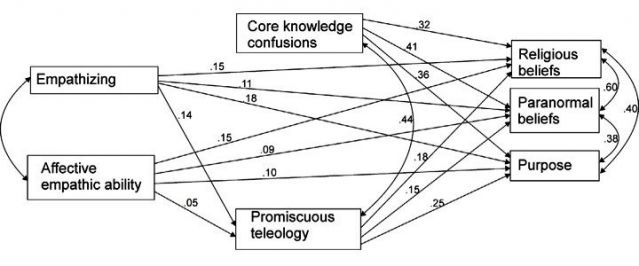Magical Thinking
Hyper-Mentalism, Hyper-Empathizing, and Supernatural Belief
The diametric model predicts the cognitive configuration of superstition.
Posted February 19, 2015

A recent paper published in Cognition—illustrated above—invokes the imprinted brain theory (which it calls the “Genetic Conflict or GC theory”), and comments that it
posits that the specific combination of strong mentalizing coupled with poor understanding of the physical world results in religious, magical and superstitious beliefs, and in severe cases, even in delusions of intentions, conspiracy and being spied upon (Badcock, 2004; Crespi & Badcock, 2008a, 2008b).
As often happens for reasons on which I have commented before, the diametric model that goes with the imprinted brain theory is frequently conflated in technical papers with Simon Baron-Cohen’s rival scheme, which has systemizing versus empathizing instead of the diametric model’s mechanistic versus mentalistic cognitive dualism. This leads to the diametric model’s crucial concept of hyper-mentalism being called “hyper-empathizing” by a number of authors.
But the delusions of being under surveillance or of conspiracies that the authors mention above do not involve empathy as such. On the contrary, it is because the sufferer is not in tune with the minds and feelings of others that we call these delusions. In fact, delusions of both being watched and of conspiracies are instances of normal mental skills being morbidly sensitive—in these cases, gaze monitoring and appreciation of shared attention. Empathizing is a separate mentalistic skill involving different cognitive systems and brain mechanisms (notably, mirror neurons). Indeed, "hyper-empathizing," if it means anything, would have to mean the kind of hyper-mentalism you find in people who empathize with animals as if they were human, feel more for the dead than for the living, or think they can pick up feelings from places or plants!
The authors go on to comment that the "GC theory does not detail whether hyper-empathizing”—hyper-mentalism in other words—“leads directly to the beliefs or whether its influence is realized through cognitive biases.” In fact, of course, hyper-mentalism implies both, because it substitutes mentalistic for mechanistic cognition, for example in making beliefs (which can only exist in minds) take precedence over facts (which exist independently of minds in the real world)—what the authors call "promiscuous teleology."
To use an analogy, the diametric model implies that we live in parallel mentalistic and mechanistic universes, with mental causality ruling the first and physical causality the second. Religious, superstitious, and magical thinking clearly represent an encroachment of the mental world on the real one in the form of belief in divine creation, miracles, the power of prayers and spells, and so on. Indeed, as I pointed out in an earlier post, you could see traditional religion and superstition as the result of a primeval mentalistic inflation which hyper-mentalized the real world, in part because mechanistic understanding of it in the form of modern science, medicine, and technology had not had time to develop. Furthermore, you could also see this as the paradigmatic historical case of a "combination of strong mentalizing coupled with poor understanding of the physical world."
The authors found that in their study “all beliefs were moderately and significantly correlated” with hyper-mentalizing. The path coefficients illustrated in their diagram at the top implied that when the effects of the other variables were controlled for, the remaining unique effects of hyper-mentalizing/”hyper-empathizing” on supernatural beliefs were still significant, weak or moderate, giving some support to the hypothesis that hyper-mentalism predicts supernatural beliefs:
The results imply that individuals with high self-reported empathy and interest in people, coupled with poor self-reported understanding of physical causality and low interest in technical, motor, abstract, and organizable systems, had more supernatural beliefs than others. This result is remarkable because it makes the relationship between mentalizing abilities and supernatural beliefs more intelligible.
Previous posts on parallel topics:
Hyper-mentalism in Children Reporting Psychotic Experiences
Mentalism Constrains Belief in God
Evolutionary Paradise Lost? Don’t Adam and Eve It!


